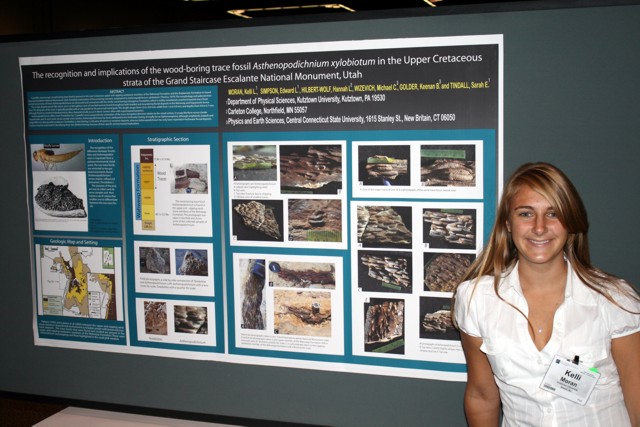
 The
recognition and implications of the wood-boring trace fossil Asthenopodichnium xylobiotum
in Upper Cretaceous strata of Grand Staircase Escalante National
Monument, Utah
The
recognition and implications of the wood-boring trace fossil Asthenopodichnium xylobiotum
in Upper Cretaceous strata of Grand Staircase Escalante National
Monument, Utah
Moran, Kelli L.,
Simpson,
Edward
L., Hilbert-Wolf,
Hannah L., Wizevich, Michael C., Golder, Keenan B., and Tindall, Sarah E.,
2009, The
recognition
and
implications
of
the wood-boring trace fossil Asthenopodichnium xylobiotum in Upper
Cretaceous strata of Grand Staircase Escalante National Monument,
Utah [abs]: 2009 Portland GSA Annual Meeting (18-21 October
2009), Geological Society of America Abstracts with Programs,
Vol. 41, No. 7, p. 262.
 A
prolific, macroscopic, wood-boring trace fossil is present in the
Late Cretaceous upper and capping sandstone members of the Wahweap
Formation and the Kaiparowits Formation in Grand Staircase-Escalante
National Monument, Utah. Detailed examination of these borings
warrants assignment to Asthenopodichnium
xylobiotum (Thenius, 1979). The morphology and
paleoenvironmental occurrence of these Asthenopodichnium are
discussed and contrasted with the similar wood-boring ichnogenus
Teredolites, which is widely considered a marine/estuarine trace
fossil.
A
prolific, macroscopic, wood-boring trace fossil is present in the
Late Cretaceous upper and capping sandstone members of the Wahweap
Formation and the Kaiparowits Formation in Grand Staircase-Escalante
National Monument, Utah. Detailed examination of these borings
warrants assignment to Asthenopodichnium
xylobiotum (Thenius, 1979). The morphology and
paleoenvironmental occurrence of these Asthenopodichnium are
discussed and contrasted with the similar wood-boring ichnogenus
Teredolites, which is widely considered a marine/estuarine trace
fossil.
The scoop-shaped, pouch-like traces occur as ferruginous casts of
tree bark and are found throughout both braided and meandering
fluvial deposits in the Wahweap and Kaiparowits formations. The long
axis of the trace is typically parallel with or sub parallel to the
preserved wood grain. The length ranges from 5.0 to 29.0 mm, width
from 1.6 to 9.0 mm, and depths from 0.8 to 6.7 mm. Although found as
isolated individual traces, they characteristically occur in dense
clusters often with superimposed pouches.
Asthenopodichnium differs
from Teredolites by: 1) parallel versus perpendicular orientation of
the trace elongation direction relative to the wood surface, 2)
scoop-like form versus clavate shaped tube, and 3) semi-circle
versus circular cross-section. Asthenopodichnium
has been attributed to the freshwater boring of mayfly larvae
(Ephemeroptera), although
amphipods, isopods and dragonflies are also possible producers. Teredolites, a clam boring, is
indicative of marine or estuarine deposits, whereas Asthenopodichnium has only
been reported in freshwater fluvial deposits. Caution must be
exercised in identifying these two distinct borings because of their
specific environmental implications.

 The
recognition and implications of the wood-boring trace fossil Asthenopodichnium xylobiotum
in Upper Cretaceous strata of Grand Staircase Escalante National
Monument, Utah
The
recognition and implications of the wood-boring trace fossil Asthenopodichnium xylobiotum
in Upper Cretaceous strata of Grand Staircase Escalante National
Monument, Utah 
 The
recognition and implications of the wood-boring trace fossil Asthenopodichnium xylobiotum
in Upper Cretaceous strata of Grand Staircase Escalante National
Monument, Utah
The
recognition and implications of the wood-boring trace fossil Asthenopodichnium xylobiotum
in Upper Cretaceous strata of Grand Staircase Escalante National
Monument, Utah  A
prolific, macroscopic, wood-boring trace fossil is present in the
Late Cretaceous upper and capping sandstone members of the Wahweap
Formation and the Kaiparowits Formation in Grand Staircase-Escalante
National Monument, Utah. Detailed examination of these borings
warrants assignment to Asthenopodichnium
xylobiotum (Thenius, 1979). The morphology and
paleoenvironmental occurrence of these Asthenopodichnium are
discussed and contrasted with the similar wood-boring ichnogenus
Teredolites, which is widely considered a marine/estuarine trace
fossil.
A
prolific, macroscopic, wood-boring trace fossil is present in the
Late Cretaceous upper and capping sandstone members of the Wahweap
Formation and the Kaiparowits Formation in Grand Staircase-Escalante
National Monument, Utah. Detailed examination of these borings
warrants assignment to Asthenopodichnium
xylobiotum (Thenius, 1979). The morphology and
paleoenvironmental occurrence of these Asthenopodichnium are
discussed and contrasted with the similar wood-boring ichnogenus
Teredolites, which is widely considered a marine/estuarine trace
fossil.